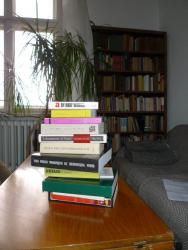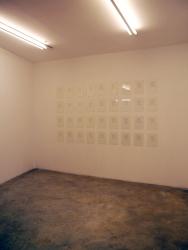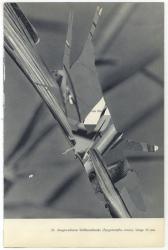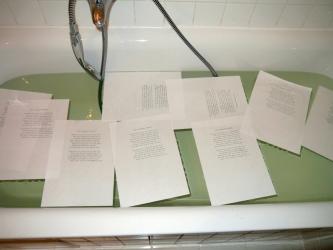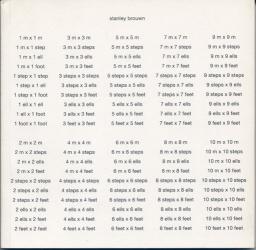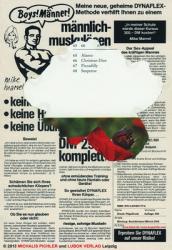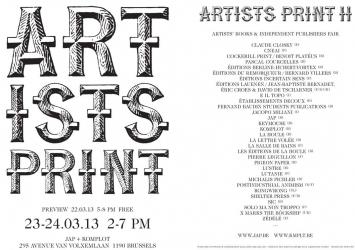news
Critical, experimental, artist-led, self-published, expanding the boundaries of book art media Fri, 28/6 2013: 4 – 10 pm (followed by an afterparty at Kunsthalle Wien Karlsplatz) Free admission
Sat, 29/6 2013: 1 – 10 pm
Sun, 30/6 2013: 1 – 6 pm
Kunsthalle Wien, Museumsquartier
Michalis Pichler
30/6 2013
2pm / 14:00 Uhr
Lecture /Vortrag
The Power Plant is proud to present Postscript: Writing After Conceptual Art, featuring paintings, sculpture, installation, video and works on paper from the 1960s to the present by over fifty artists and writers exploring the artistic possibilities of language.
& : Christophe Daviet-Thery Livres et Editions d’Artistes 34 rue Louise Weiss 75013 Paris tel : + 33(0)1 53 79 05 95 fax : + 33(0)1 43 54 74 93 www. daviet-thery.com
blog: davietthery.wordpress.com
Within the framework of Zone D by Zoumboulakis Galleries, the group exhibition "Mehr Als Schein / Shining Through / Αυτό που φαίνεται", curated by visual artist Mark Noll, opens on 17 May 2013.
The exhibition, in which 19 artists participate (who live and work in Germany, in Greece and in Cyprus), is held in a neoclassical building in Ermou Street near important archeological areas (the Acropolis, the Keramikos ancient cemetery, the Ancient Agora of Athens etc.).
artworks, mock-ups, and derivative works by:
KUNST VERSTECKEN / HIDING ART am Freitag, 5.April 2013 um 20 Uhr Nichts sehen / Nichts hören / Kunst verstecken: —- Nothing to see / Nothing to hear / Hiding Art
Konzert und Ausstellung
In accordance with the Easter tradition, we present an interactive festival between art and music. The festival is more about hiding than showing art. We present a room full with art and music, where you don`t see anything at first sightb by stepping into the gallery. Numerous artists placed their works in our space. There is also the possibility to bring works spontaneously during the exhibition night.
& : Christophe Daviet-Thery Livres et Editions d’Artistes 34 rue Louise Weiss 75013 Paris tel : + 33(0)1 53 79 05 95 fax : + 33(0)1 43 54 74 93 www. daviet-thery.com
blog: davietthery.wordpress.com
at the gallery on 12th April - 22th May, 2013.
Vernissage: Friday 12th April at 6pm-9pm
Esthétique du livre d’artiste, collections et inventaires curated by / Commissariat: Anne Moeglin-Delcroix Artistes
Alighiero Boetti, Christian Boltanski, George Brecht, Stanley Brouwn, Jeffrey Brouws, Ludovic Burel, Ulises Carrión,
Bernhard Cella, Maxime Chanson, Claude Closky, Simon Cutts, herman de vries, Mark Dion, documentation céline duval, Patrick Dubrac, Jean-Baptiste Farkas, Hans-Peter Feldmann, Robert Filliou, Antonio Gallego, Anne-Valérie Gasc,
Marie-Ange Guilleminot, Dick Higgins, On Kawara, Erik Kessels, Pascal Le Coq, Jean Claude Lefevre, Sol Lewitt, Jackson Mac Low, Roberto Martinez, Bruce Mclean, Annette Messager, Jonathan Monk, La Monte Young, Simon Morris, Maurizio Nannucci, Michalis Pichler, Peter Piller, Richard Prince, Hubert Renard, Yann Sérandour,
Mieko Shiomi, Daniel Spoerri, Dieter Roth, Jean-Jacques Rullier, Allen Ruppersberg, Edward Ruscha, claude rutault, Erica Van Horn, Wolf Vostell, Hans Waanders, Éric Watier
Programm ab 19 Uhr:
Musik von Alexander Binus (Gitarre) und Sebastian Kunzke (Tuba) und einer Lesung mit Michalis Pichler
The Berlin based artist and self publisher Michalis Pichler works conceptually, often in series and with vernacular material. He uses various media like text, publication, photography and collages but also sculpture and interventions in public space. He calls his works «appropriations». This refers to the Appropriation Art, that arose in the 80s in New York. Their protagonists deliberately create copies of art works, thus as an independent artistic practice to question the established idea of artistic originality. The publication shows 24 full-page reproductions of advertisement pages of magazines. Their profane familiarity is interrupted by cut-outs and collages. Boys! Männer! with 24 full-page figures in a four-colour offset print, paperback, 24 pages, 21,6x14,6 cm, edition of 500, 12,- EUR
ARTISTS’ BOOKS & INDEPENDENT PUBLISHERS FAIR PREVIEW 22.03.13 5-8 PM FREE
23-24.03.13 2-7 PM
JAP + KOMPLOT
295 AVENUE VAN VOLXEMLAAN 1190 BRUSSELS

